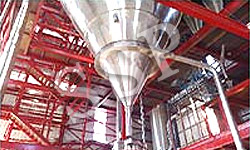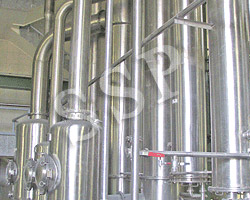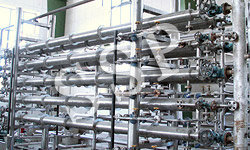 Coffee Creamer Plant
Coffee Creamer Plant
 In some countries non dairy creamer / coffee whitener is used for whitening of coffee or tea.
In some countries non dairy creamer / coffee whitener is used for whitening of coffee or tea.
Non dairy creamer / coffee whitener normally consist of :
- Maltose syrup - 60 to 64.5%
- Corn / Palm Oil - 30.8 to 35%
- Sodium Caseinate - 2.1 to 2.5%
- Emulsifying agent - 0.05%
- Moisture - 2.5%
The manufacturing process has the following steps
- Mixing of ingredients
- Homogenization of mixture
- Spray drying
Plant operations
The canisters, stacked in layers on a pallet, are placed on a rotary table that discharges into a downward chute made of twisted metal rods.
The worker can manually place a scoop into each canister as it passes on through the conveyor. The row of cans pass beneath a rotary auger filler set to deposit the correct quantity of coffee. After filling, the canisters pass through a can seamer that applies a metal bottom. This is followed by a ink-jet coder that prints the manufacturing date to the metal bottom.
After this, the twister sets the canisters upright on the conveyor that are conveyed to an applicator for plastic overcaps. Side belts move the cans through the unit and the over-caps are fixed on the top portion of the foil membrane. Finally, the cans are delivered to a rotating accumulation table.


 Starch can be produced from various starch containing materials like maize, cassava / Tapioca roots, potatoes, wheat, rice etc. There are different technologies for each raw material for recovery of starch. Starch is mostly used for industrial purposes
Starch can be produced from various starch containing materials like maize, cassava / Tapioca roots, potatoes, wheat, rice etc. There are different technologies for each raw material for recovery of starch. Starch is mostly used for industrial purposes 1. Food industries as glucose, dextrose, fructose, sorbitol, maltodextrin as filler and sweetener
1. Food industries as glucose, dextrose, fructose, sorbitol, maltodextrin as filler and sweetener
